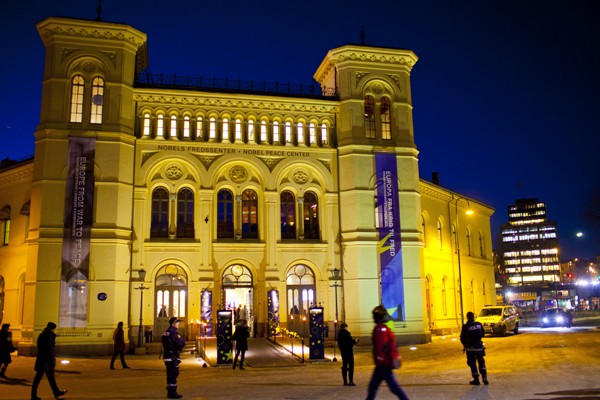Post by Matthew Teller
Alfred Nobel was Swedish, and the annual prizes administered in his name are all presented in Stockholm – except the most famous, the Nobel Peace Prize. Why is this one awarded in Oslo, and why is Norway involved at all?
Nobel Peace Center
On Oslo’s picturesque waterfront, behind the glorious lump of mid-century modernism that is City Hall, a graceful building of symmetrical arches and low towers diagonally breaks the corner of the harbour square.
For more than a hundred years this was a railway terminus, handling trains to and from Stavanger and Kristiansand on Norway’s west coast. Following a railway revamp during the 1980s, trains were routed instead into subterranean tunnels and the building – dating from 1872 – was gutted and restored. It has now reopened as the Nobel Peace Center.
It’s a splendid visit, even if you’re only in Oslo for the weekend. Remodelled inside by British architect David Adjaye, this elegant museum serves as a showcase for the ideals of the Nobel Peace Prize.
The downstairs halls are given over to temporary exhibits on sweeping cultural themes. When I visited there was a photography exhibit examining ideas of European identity – quirky and thought-provoking. Soon after, ‘What The World Eats’ was opening, looking at the relationship between eating habits and the natural environment.
This global perspective serves as a prelude to the more specifically Nobel-themed galleries upstairs.
First comes a detailed celebration of the current Peace Prize winner, installed afresh each December following the award ceremony for that year’s prizewinner.
Visitors move through to the Nobel Field, a darkened room with ethereal muzak, ‘sowed’ with panel screens displaying information on the peace prize laureates – all 124 of them. Mother Teresa (1979) and Martin Luther King (1964) might be familiar, but it was fascinating to read of the idealism of Frank Kellogg (1929) and the vision of Rigoberta Menchú Tum (1992).
There’s more contextual background in the Wall Papers room, with big screens offering themed panels summoned up by sliding pointers – informative, but a bit old-fashioned now, in these days of touch-screen technology.
Alfred Nobel, in life and death
Then comes a room telling the story of Alfred Nobel’s life, and the backstory starts to emerge. Born in Stockholm in 1833, Nobel trained as a chemist. He seems to have been a solitary and somewhat troubled man. He never married, devoting all his energies to building up a manufacturing empire based on weapons of war, including his most famous invention, dynamite.
A change came in 1888. That year Nobel read his own obituary, published in error by a French newspaper under the stinging headline “The merchant of death has died”. It seems to have given Nobel pause. The 55-year-old rewrote his will.
Eight years later, after Nobel’s death, it was revealed that this fabulously wealthy tycoon had allocated 94% of his total assets – amounting to some £1.6 million at the time, an immense sum – for a prize fund recognising those who confer ‘the greatest benefit on mankind’. Nobel Prizes in chemistry, physics, medicine and literature (and, later, economics) were all to be awarded in Stockholm, whereas a Nobel Peace Prize was to be in the control of a Norwegian committee, awarded annually in Oslo.
Why Oslo?
There are several possible explanations for the split. In the 1890s, Norway was closely involved in developing strategies to resolve conflicts through international mediation; one theory says Nobel may have thought it a more appropriate setting for a peace prize than militaristic Sweden.
Another idea is that Nobel sought to distance himself from his own life’s work – which did so much to facilitate warfare – by giving a special focus to a peace prize. At that time Sweden and Norway were ruled together in a “United Kingdom”. The relationship between Stockholm and Oslo was roughly the equivalent of London and Edinburgh. By moving the peace prize to the Norwegian capital, he could pointedly create a separation, and highlight his efforts to reward peacemaking, while still keeping all the prizes linked within what was then the same country.
Either way, when the new Nobel Peace Prize laureate is announced in October, and when they receive their prize at Oslo City Hall in December – the day before the Peace Center’s new exhibition on their work opens – the world will be watching.
That lazy 19th-century newspaper editor was no doubt reviled at the time for having printed a living person’s obituary. Yet by unintentionally pricking the conscience of a rich man, his was truly a mistake that changed the world.
Nobel Peace Center, Brynjulf Bulls Plass 1, Oslo. www.nobelpeacecenter.org/en/. Open Tue-Sun 10am-6pm (also open Mondays in summer, May-Aug). Free admission with Oslo Pass. Otherwise, adults NOK90, students and seniors NOK60, under-16s free. Free guided tours in English (May-Aug daily 12pm & 3pm; Sep-May Sat & Sun 1pm).
Matthew Teller is a freelance journalist and travel writer. He blogs at QuiteAlone.com and tweets @matthewteller.
Photo by Sara Johannessen / Nobel Peace Center
Visit the Sunvil Discovery Oslo pages for more about short breaks to Oslo, including information about its many attractions as well as suggested excursions out of the city.





